
I’ve admitted it before, and will again…. I watch what’s coming down the menswear runways for inspiration. I like to see what’s new and whether it’s something I’d like to work into my wardrobe.
Season after season it’s always Missoni that draws me in. The use of color, texture and pattern always seems so perfectly coordinated. They make it look effortless, and it might be if only one had access to all their fabulous textiles. Alas, for us mere mortals it’s a challenge to imitate the look.

I would want to live in these clothes every day if I could. But there never seems to be a spare $1,000 just laying around, waiting to be blown on a sweater (not to mention the shirt and trousers to go with it!). Can you relate?
Enter — the Phoney Missoni cardigan!
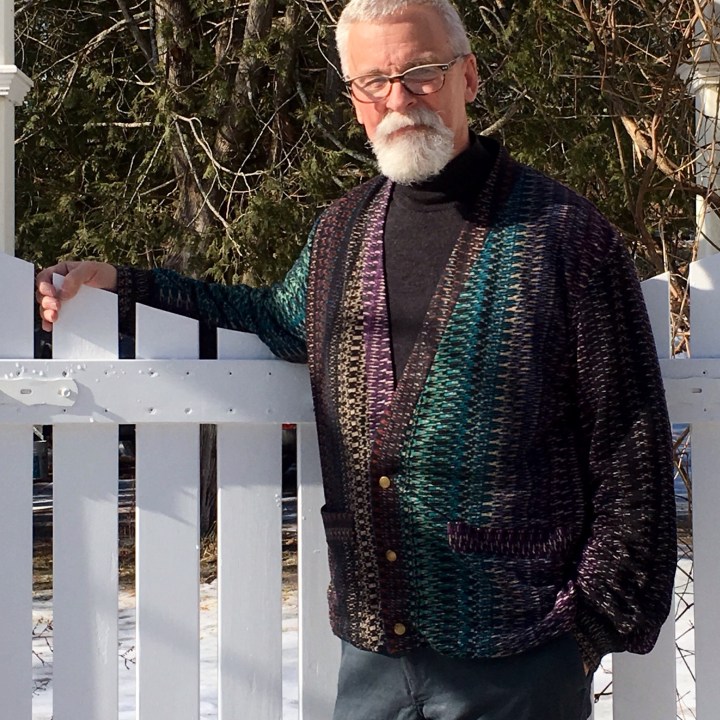

This cardigan is made from a vintage Advance pattern that I found on Etsy. The fabric is a lightweight knit from Gorgeous Fabrics. Even though the pattern is printed rather than knit, it immediately struck me as “Missoni-esque”. Plus, the purple, brown, teal colorway works with most of my me-made wardrobe. Ann sent me a sample quickly; and I can’t tell you how much THAT kind of service means to us sewists in the hinterlands! I was instantly sold.
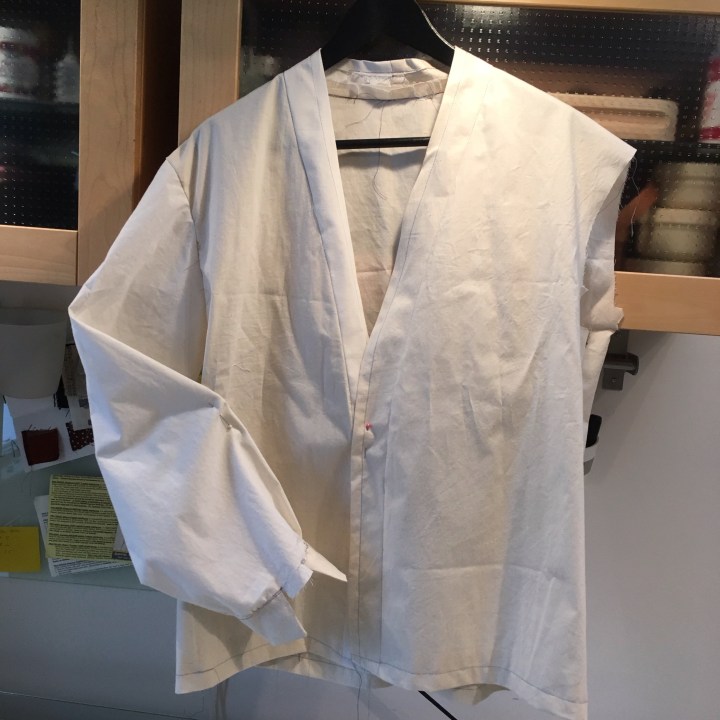
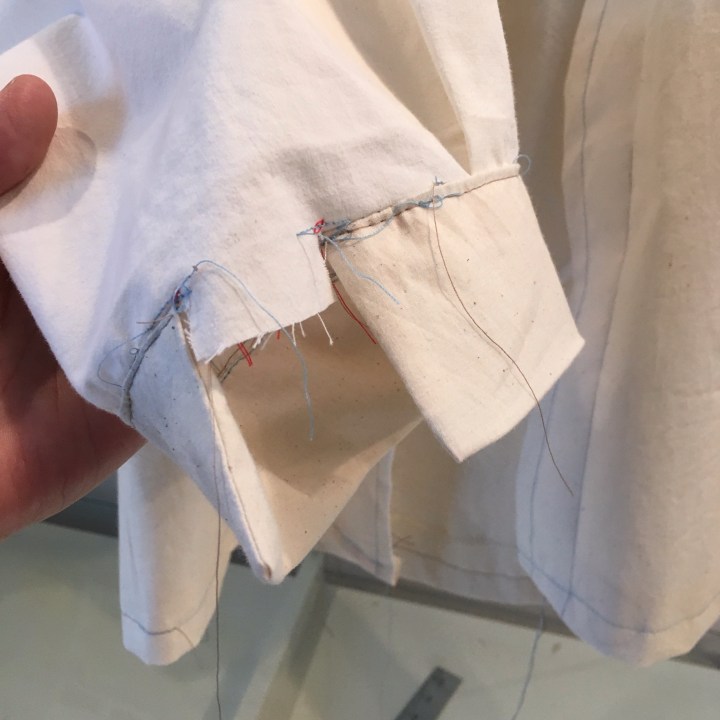
I make a muslin for everything I make. Maybe it’s a thrifty Yankee thing? I just hate to waste fabric on a project, no matter how small or simple it might appear. I cringe at the thought of a “wadder”. My muslins are always a mess (no wearable muslins in my world!). Messy as they are, they help me with fit issues AND they give me the “heads up” on the parts that may give me trouble down the road. (Like the cuff and weird space above).
This pattern has an absurd amount of ease in the sleeves. 2 inches! I’m not sure when men wore sweaters with puffy sleeves, but I’m not interested in starting a new trend.
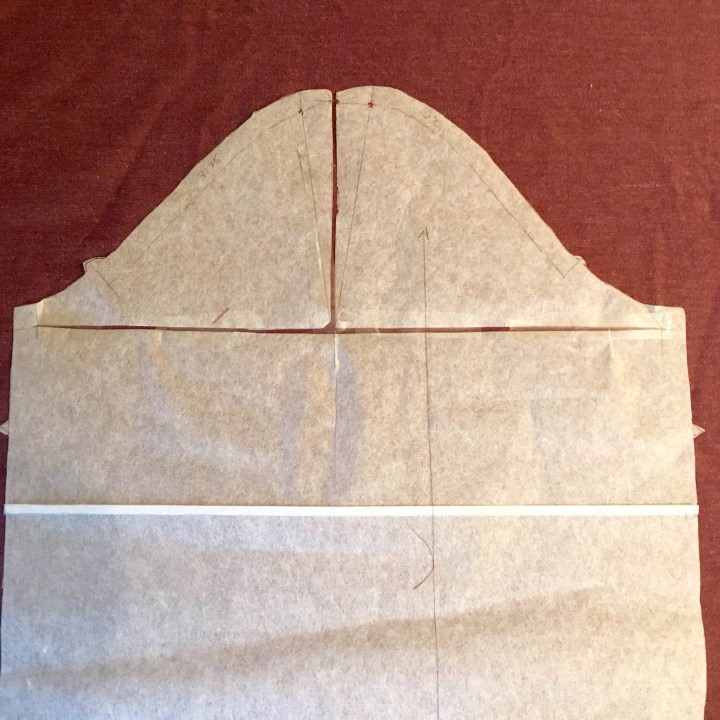
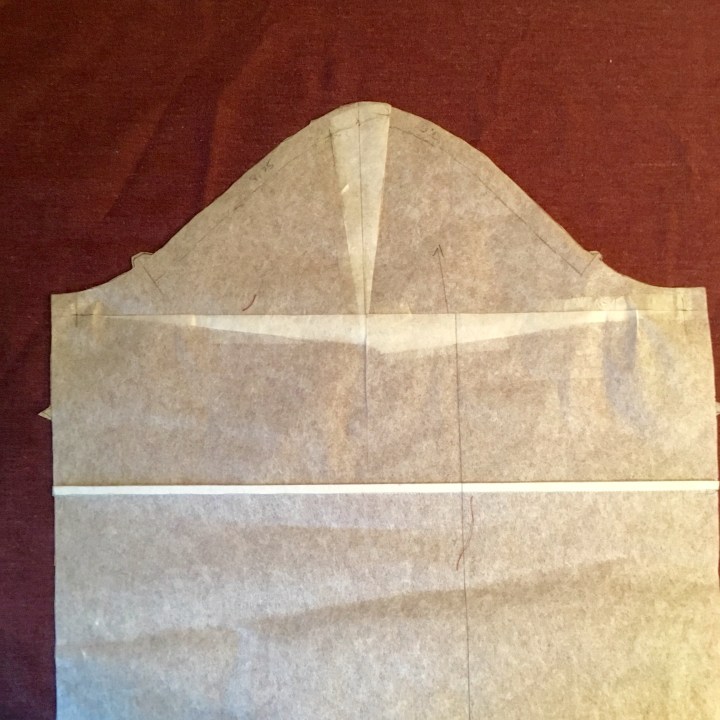
I’ve undone my pattern to show how I eliminate excess ease from a sleeve cap. I slash the pattern across from arm pit to arm pit. Then I cut down perpendicularly from the “dot” at the shoulder seam.
I measure along the seam line the amount I want to remove from the front and back of the sleeve. Draw a radius, then overlap the pattern until the lines meet. The curve will need to be trued up a bit. Easy.
I added just a bit of shaping to the side seams (they were completely straight) and shortened the sleeves by a 1/2″. (They could actually be shorter). That was it for adjustments.
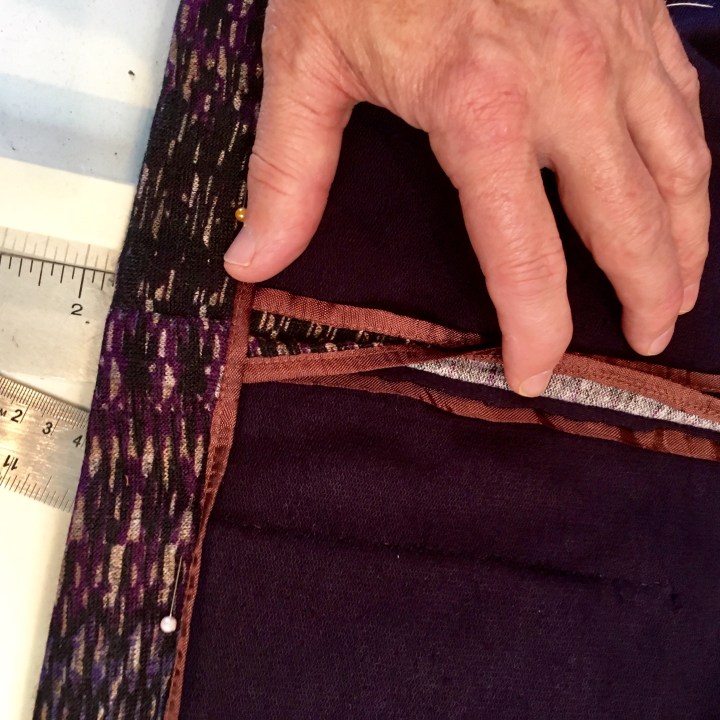
This sweater is lined with a bamboo French terry from my stash. All the seam allowances are finished off with Snug Hug rayon seam binding. There is also a strip of seam binding caught in the seams to prevent stretching. Otherwise, this sweater would stretch down to my knees.
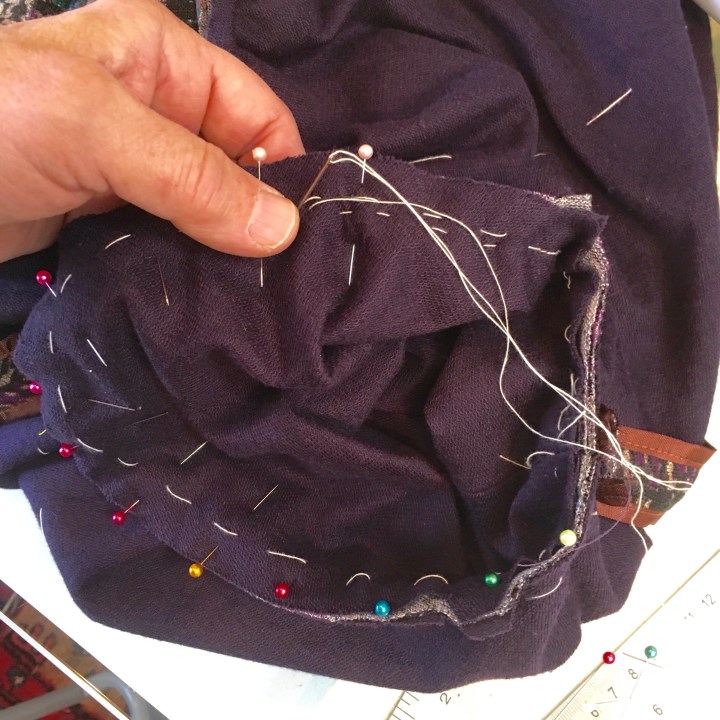
The sleeves, minus the crazy amount of ease, fit easily into the armscye. I take the time to baste my sleeves in because I hate getting jabbed by all the pins. Plus, is there anything worse than having to pick out a sleeve seam because there’s a catch in it? Drives me crazy!




Patch pockets, slouchy fit, super soft, brass snaps instead of buttons.
Fabric — Gorgeous Fabrics
Lining — Vogue Fabrics (deep stash)
Interfacing — Fashion Sewing Supply — (Pro-Weft supreme medium weight fusible)
Snaps — JoAnn’s
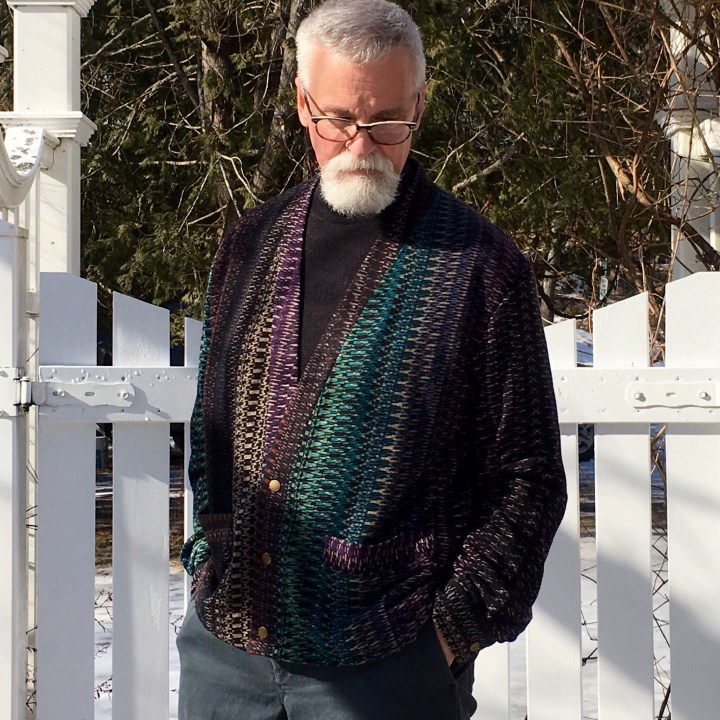
Polar vortex begone!! Time to start thinking about a Spring project.
Happy mid-winter sewing to all.
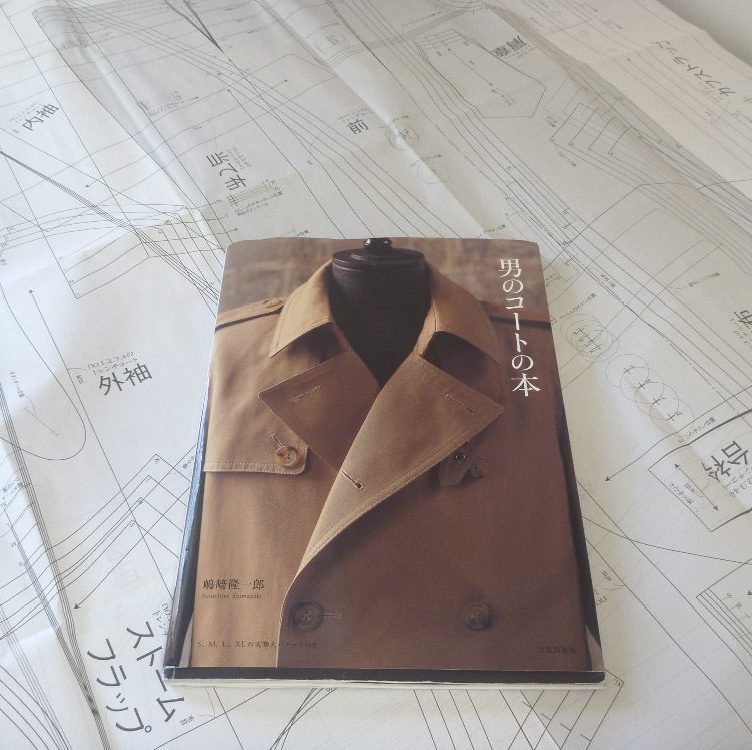
Another beautiful garment!
LikeLiked by 1 person
Thank you, for reminding me of another area of my grandmother’s talent. The suits she sewed for my grandfather! Thoroughly enjoy seeing your projects! Wonderful! I’ve never had interest in the ladies fashion runways. But the Men’s Runway could draw my attention! Civility with class… and charm! 😉
LikeLike
Wow, that looks so much like a knit. Great job!
LikeLiked by 1 person
AWESOME–and the fit of this design is great. Yet FIT is what you do so well. Love your work. Beautiful job. Handsome guy, too, if I may say so!
LikeLiked by 2 people
I think Mr Rodgers would find this too fashionable and doesn’t have that homemade look that he seemed to wear. I have never thought about lining a sweater before, I’m curious as to the benefit, ie. stabilize the knit fabric? I also recall you using lining in your other missoni jackets. I really like the snug hug, it is great for using to stabilize seams on shoulders for knit fabrics. I am also wondering why you chose that interfacing over tricot knit interfacing? and to sum it up, your sweater is totally terrific.
LikeLiked by 1 person
I only lined this because the knit is quite thin and I wanted more heft to the garment. Finding sweater knits that I like has been a challenge, mostly because I’m not usually looking in the knit section! For some reason knits scare me. Silly, but true. The interfacing is a product that I love, and I always have it on hand. It produces just the right amount of structure, which is so important to menswear.
LikeLike
Does the cuff have a button? Because I do remember sewing patterns with cuffs like that one that overlapped, making a little pleat in the sleeve. They always felt like a cheap option, although with a thicker garment they might be an option.
LikeLiked by 1 person
Yes, the cuff snaps and it does make a pleat. I had never seen this before. If the sleeve isn’t lined it’s a big mess IMO.
LikeLike
A really nice looking cardigan and love the snaps rather than buttons, interested that you make a muslin for everything, living in England the cost of muslin adds quite a lot on top and unless the material is very expensive then not always worth it. I certainly see the benefits though, Do you have a good instruction method for lining items as I am making a jacket and wish to line that. You must have
a lo of patience which is obvious by the amount of care and detail, appreciate your work, great.
LikeLiked by 1 person
I learned from Peter at Male Pattern Boldness that thrift store sheets make great inexpensive muslin material. I’ve also turned to the thrift store for shirt buttons on occasion. The cost of the whole shirt can be less than the price of a set of new buttons. If it’s a flannel shirt, I chop it up and save the pieces for pocket linings.
If you think a pattern is “a keeper”, something that you would make over and over, a muslin is always worth the time and effort.
The lining in this sweater is technically an underlining. I cut out the lining piece using the same pattern piece as the garment, then baste it wrong sides together to the fashion fabric. I cut off the hem allowances to reduce the bulk there. Then I just treat it as a single piece. After sewing, I trim out the lining seam allowance as close as I can, then bind the fashion fabric seam allowance for a clean look.
LikeLiked by 1 person
This is really classy. I love the colours and placement. Nice and easy to wear too!
Here’s to spring!
LikeLiked by 1 person
Lovely garment, and great workmanship!
How do you do the seam finishes? Just fold the tape over the rough edge and stitch?
LikeLike
I did a little mini tutorial on how I use seam binding in the post “Red Pants for Fall”. Doing it with a stretchy knit is a little challenging. Basting the tape to the seam allowance before doing the first line of stitching will help keep things flat. It takes a little more time, but worth it.
LikeLike
Thanks, I had forgotten about that blog post. I guess I’ll need to find some of that stuff and experiment with it some. When I have been using tape, it’s been bias tape and a Hong Kong finish technique.
LikeLike
This is gorgeous! As usual. You know, if’n you want Missoni at bargain basement prices, learn to knit. I am absolutely serious. Go here and scroll down to see the Missoni-inspired blanket I knit for my parents several years ago.
https://helenkosings.wordpress.com/2013/01/17/writing-for-the-blog-is-still-writing-yes/
If you can tie your shoes, you have all the manual dexterity needed to knit. Plus it is kind of like doing puzzles mixed with yoga plus texture and color, since you are creating the fabric as well as the architecture of the thing you are making. Someone with your delight in craftsmanship would make a TREMENDOUS knitter.
And handmade wool socks are the best thing ever when it’s even slightly cold. I live in Alabama but I am originally from NH – where I first started making socks 40+ years ago. The yarns are so much nicer now…and check out Ravelry (free registration required). So many free patterns, so much available…..yum.Once you sign up, go to the patterns advanced search and type in “Missoni” and you’ll see pictures of Missoni style projects that some of the 3 million subscribers to Ravelry have made and posted. Then, do another search with “Noro” as thy keyword, or if you don’t wanna sign on to Ravelry yet, just check this out – Eisaku Noro is a color GENIUS-
http://www.eisakunoro.com/html/home/index.html
LikeLiked by 2 people
Your blog, your choices to make an attractive men’s look work, are great. Thank you for sharing
LikeLike
I just love your blog. It keeps inspiring me to take the time to care about small details for a better fit and finish. And to start sewing some clothes for my husband.
The wonderful Tessuti fabrics here in Australia sometimes have original Missoni fabric in stock if you ever want to try sewing with the real thing. It is expensive of course (as is postage to the US) but only a fraction of the price of a Missoni garment. Mind you, your Missoni-esque cardigan is a wonderful alternative.
LikeLiked by 1 person
Love to see this wonderful hand tailoring. My other hobbies have led me away from textiles. Maybe one day I’ll get back.
LikeLiked by 1 person